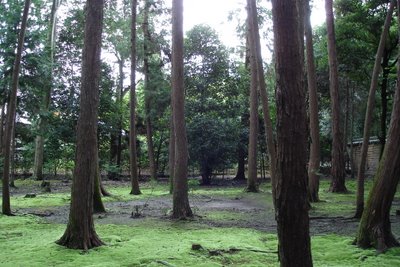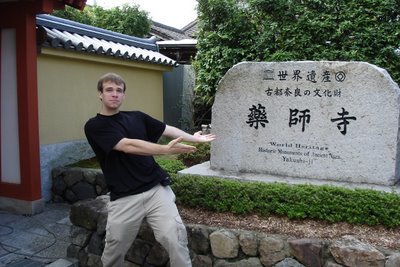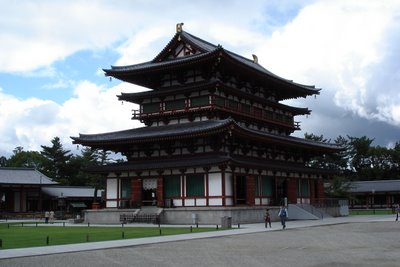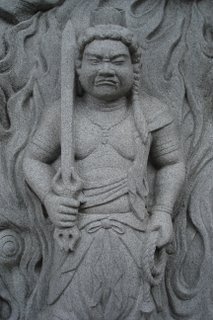Nara Part I: Toshodaiji and Yakushiji

It was probably around ten in the morning when the five of us pulled into the parking lot at 唐招提寺 Toshodaiji, our first temple for the day. Toshodaiji was founded by a Chinese monk from the T'ang dynasty (618-907 CE) at the invitation of the devoutly-Buddhist Emperor Shomu (r. 724-749) as a centre for Nanzan, a Buddhist sect that I have never heard of. The monk Ganjin accepted the Emperor's offer, and though it would take him more than twelve years, require five unsuccesful crossings, and cost him his eyesight, he arrived in Japan in 754 CE, a half-dozen years after Shomu had abdicated in favour of his daughter. Ganjin would serve for some time at Todaiji temple, which we visited after lunch, before constructing Toshodaiji in 759 CE. He passed away four years after that.
 There is a wooden statue of Ganjin preserved from this ancient time at Toshodaiji. It is kept hidden from the public except on June 6th, a day that corresponds with the anniversary of Ganjin's death on the old lunar calendar.
There is a wooden statue of Ganjin preserved from this ancient time at Toshodaiji. It is kept hidden from the public except on June 6th, a day that corresponds with the anniversary of Ganjin's death on the old lunar calendar.The temple complex also houses several more generic statues which are open to the public, and stunning to behold. Unfortunately, tourists are not allowed to take pictures of the images. I did manage to snap some shots of the gorgeous moss garden that the temple complex is nestled in.

Next on our list was another temple, 薬師寺 Yakushiji, which actually predates Toshodaiji by about six decades – it was planned by Emperor Temmu (d. 686) in the late seventh century, and was completed by his wife and successor Empress Jito in 698. The temple was moved to its present site in Nara in 718, following the relocation of the capital.

That's Patrick, doing his Patrick thing at the headstone outside the main gate.
Though Temmu was primarily interested in developing a form of Buddhism based on the Golden Light and Benevolent Kings sutras that would benefit the state, he was not above relying on the mystical powers of Buddhist rites and magics. Temmu started construction on Yakushiji in November of 680 as part of prayers for the quick recovery of his Empress from illness. Jito recovered, but when Temmu fell ill four years later similar rites were ironically ineffectual. Nevertheless, Jito continued construction of the temple, and in 697 the chief Buddha of the temples, 薬師如来 yakushi nyorai was enshrined.
The contents of the Yakushi Sutra indicate why the emperor should have turned to it at a time of personal crisis, for it tells of a perfect Buddha of Healing (Yakushi Nyorai), unsurpassed in wisdom, who vowed to bless individuals on the path to Buddhahood. The seventh vow must have been especially appealing, for there Yakushi promises to help “all ill and helpless sentient beings to achieve recovery, to be blessed with peace and joy of body and mind, to become wealthy, and to obtain the state of enlightenment by hearing his name.”
From: Sonoda Koyu, “Early Buddha Worship,” The Cambridge History of Japan Volume 1: Ancient Japan (Cambridge: Cambridge University Press, 1993), pp 395.
The Yakushi Triad at the temple consists of yakushi nyorai and two attendant 菩薩 bosatsu (Skt. bodhisattva). 日光 nikko (Skt. Suryaprabha) attends on the right side, and represents sunlight. On the left is 月光 gakko (Skt. Candraprabha) who represents moonlight. All three statues stand around three metres high, and were cast in sinuous and graceful bronze. They have been passed down from the end of the seventh century, though all three lost their gold covering in a fire in 1528 that destroyed most of the temple complex. The main hall of the temple, though resplendant, dates from 1976, and the Yakushi Triad it houses has been stained a glossy black.


If you look closely at the last picture you can see my Religious and Traditional Rites professor, he's dressed all in beige, leading a group of students from Conan University, at which he teaches a similar course.
I managed to find a statue of fudo myo-o out back. The myo-o are a set of fierce protective deities in Japanese Buddhism, each corresponding to an important Buddha. Among the five chief myo-o, fudo is the only one I can recognize on site – he is depicted as holding a rope in his left hand, with which he binds evil spirits, and a sword in his right, with which he cuts away clouding thoughts. He corresponds with rushana buddha, (Skt. Vairocana) whose giant statue is enshrined at 東大寺 todaiji which we visited later. Stay tuned!
This is fudo's ugly mug.


0 Comments:
Post a Comment
<< Home